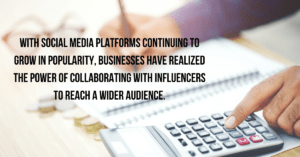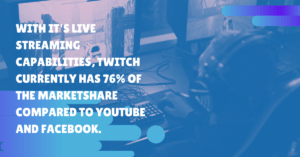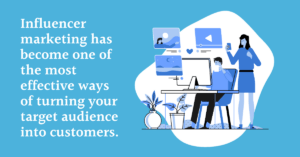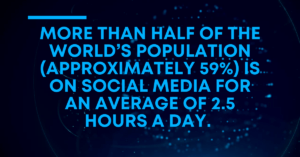Influencers are the key to any successful retailer’s strategy. They allow brands to build their reputations as authentic, personable, and desirable by building solid relationships with popular creators in their industry’s limelight.
In the wake of the COVID-19 pandemic, ecommerce has boomed, and that boom will roll into the holiday season with no slow in momentum. As a result, small businesses need to be ready with efficient, multi-channel influencer marketing strategies to cope with online consumers’ changing needs and interests.
Here are some of the best ways to prep your influencer marketing Black Friday ecommerce strategy.
Why Ecommerce is Key to Black Friday and Cyber Monday This Year
As the pandemic raged in 2020 and into 2021, brick-and-mortar stores were forced to close. This meant that consumers who might typically shop in person made the transition to ecommerce to meet their daily needs. Everything from groceries and home goods to luxury items became available online only.
Now, a year on from the onset of the Coronavirus pandemic, retail sales numbers have returned to pre-pandemic levels, even exceeding them. This is thanks to the ecommerce boom, which occupies nearly 35% of all sales figures for March of 2021 (up from 23% in March of 2020).
Fashion and textile sales have seen particularly high growth at more than 78% since March of 2020, while other categories have seen at least modest growth in that time.
Strangely, this trend does not look as if it will end with the end of the pandemic, whenever that may come. According to some sources, roughly a third of all millennials interviewed stated that they didn’t miss traditional shopping and instead preferred to participate in ecommerce from their favorite brands.
Black Friday, Cyber Monday, and Current Buyer Trends
It’s not just the location of shoppers that’s changed; their habits have evolved to match the pandemic’s conditions as well.
A survey from Business Wire found that roughly half of all shoppers will start holiday shopping much earlier in the season than they did in previous years, to account for shipping times and shortages.
More than half of the respondents also stated that they planned to have their gifts shipped directly to the recipients and intended to buy last-minute gifts (such as stocking stuffers) via online shopping. But, perhaps most impressive is that 76% of all respondents stated that they intended to purchase more than half of their total gift list online.
Another survey from McKinsey was in agreement, noting that 75% of their responders tried new behaviors while shopping, including participating in e-commerce. They also stated that 36% of responders showed a willingness to try new product brands, meaning that there is less strict brand loyalty than last year.
Finally, this information is corroborated by a study from Business Insider, which reveals that 2022 is projected to be the first trillion-dollar year of e-commerce sales thanks to the pandemic’s shifting trends. As a result, they expect retailers to ramp up digital offerings to meet this influx of demand.
What are the Best Social Channels for Promoting Ecommerce Sales?
Understanding who you’re advertising to is only half the battle; now, you need to decide where you’re going to place your advertisements to get the most ROI. Here are some of the best social media platforms you can use to promote e-commerce sales and brand awareness.
YouTube
YouTube is aimed at longer-form content, making it an excellent place to showcase your brand’s story and personality, allowing you to build a dedicated subscriber base. Beyond that, sponsored YouTube videos from more prominent creators in your field can increase your reach substantially, allowing you to expose your brand to new potential buyers while automatically garnering trust.
Here are some of Sideqik’s tips for running a successful YouTube channel for your brand.
- Post genuine, personalized content on a consistent schedule to allow for better engagement.
- Take advantage of YouTube’s built-in content creation tools (such as annotations, cards, and metadata) to make sure your videos are as clean, well-polished, and optimized as possible.
- Share your videos widely across other social networks, and tag them as relevant using mentions and hashtags to increase your reach.
Instagram’s heavily visual content is perfect for showcasing your products. With their recent shift to focus more on the shopping aspect of the user experience, you can now take advantage of having a dedicated storefront to drive sales directly from posts with appropriate tagging.
Their latest technological advance, a virtual “try on” feature offered to select brands, has the potential to drive e-commerce sales for the fashion and cosmetics industries even further, allowing customers the convenience of testing a product before buying in the digital space.
By engaging directly with your Instagram audience, you can encourage brand loyalty, conversion, and word-of-mouth advertisement by sharing visually interesting or storied content.
TikTok
TikTok, the spiritual successor to now-defunct Vine, is still a relatively new playground for brands hoping to include it in their digital marketing strategy. However, the site is famous for having short, catchy content that focuses on music, memes, or challenges. In short, the content is exceptionally interactable.
The true power of TikTok lies with its influencers, though. Creators with millions of followers are gaining more and more recognition in the traditional media world. They do so by showcasing themselves and their personalities rather than advertising a specific product, as seen in Super Bowl advertisements that featured popular figures from the app, such as Charlie D’Amelio.
Working with a TikTok influencer, though it’s tricky due to recent guideline changes for branded content, can drive brand recognition and revenue through interactability and the sheer scale of their reach.
Traditional Blogs
Though somewhat less advertised than other social media formats, traditional bloggers still have significant impacts. Tailored, consistent content for a particular industry niche can allow bloggers to build up massive followings, both on the blogs themselves and through promotional social media channels.
Reaching out to a traditional blogger in your industry can help you reach new customers and build brand recognition and trust with returning customers. You can also form a lasting relationship with a powerful influencer, meaning that you can get repeated backlinks to your site through high-quality content, which goes a long way to improve SEO.
Sideqik’s tip for working with bloggers comes from Julia Fain of Tag & Tibby. Julia says that, to partner with bloggers, brands should do some research into the blogger and their site history. Understanding the content they produce and their personalities can help you tailor a mutually beneficial marketing strategy. She suggests reaching out via social media and tailored emails.
The Channel Where Your Customers Are
Of course, the most important social channel for promoting your e-commerce brand is the one to which your intended audience already flocks. Understanding that audience is the first step in the process, as it will allow you to target fewer but more effective social channels and focus your efforts.
You’ll need to research your current customer base to understand your target demographic. Ask your existing customers which sites they frequent, do independent research on your audience’s shopping habits. This will give you a general idea about the most popular sites for your potential audience.
Choose two or three of these sites and find out what the popular tags are for your industry and who the top influencers are. You can do this by simply using the sites’ in-built search functions and taking advantage of statistic sites like Social Blade to see overall engagement rates.
From there, you can create branded accounts and start building your content catalog to grow your account.
How to Use Influencer Marketing to Improve Your Black Friday Ecommerce Strategy
As noted, influencer marketing is the key to boosting e-commerce sales through social media channels. It can be tricky to navigate this strategy, though; coming across as inauthentic can kill a campaign quickly, but trying to be too personal can be off-putting. As a result, you’ll need to put careful consideration into your marketing plan.
Firstly, vary the kinds of influencers and content you work with. Yes, massively popular influencers will give you greater reach, but micro-influencers may have a more dedicated and actionable fanbase that can drive sales more directly. You also shouldn’t settle for only static posts; videos are a great way to drive interest! So don’t forget to include micro-influencers and video collaborations into your strategy.
You should also allow influencers to lead the way when choosing the content to be made. It is, after all, their page and the audience you’re working with. They will know their audience very well and understand the kind of content that’s most likely to garner results.
Take advantage of current trends to drive your campaign. Things like unboxing videos (done with gifted products to select influencers) can drive interest in your products themselves by offering sneak previews of potentially unreleased or limited edition merchandise, while challenges, such as those on TikTok, can drive interest in your brand.
You should also offer incentives to both influencers and their audiences. Give influencers unique Black Friday/Cyber Monday discount codes to offer their audience and include influencers in your more traditional marketing Black Friday campaigns. This gives them more reach and gives you more relevance to your potential audience.
Think About How Buyers Adjust Shopping Behavior for the Season
Remember that shoppers during the holidays will adjust their buying behavior. Instead of shopping primarily for themselves, they are often looking for gifts for their loved ones. So, tailor your marketing toward the ideal customer experience; center your ads on the idea of your product being giftable and desirable to a wide range of people.
As a part of this adjustment, you’ll want to take the channels of your buyers into account. Understand that most television and traditional media viewers are going to do more research online about featured brands they find interesting on their mobile devices, so be sure to tie your traditional advertisements to your dedicated social media channels.
You can often do this by featuring stills or snippets from traditional ads as video content on the pages themselves and including your brand’s handles or tags in the advertisement.
Examples of Awesome E-commerce Campaigns as Inspiration
Here are some successful e-commerce campaigns you can look to as an example to inspire your brand’s strategy this Black Friday/Cyber Monday.
Death Wish Coffee
Death Wish Coffee, known for the “World’s Strongest Coffee,” took full advantage of organic influencer marketing (and Sideqik’s all-in-one influencer marketing platform) by sending out care packages containing their new iced coffee to 44 influencers across the fitness and gaming worlds without offering any instructions or stipulations.
These influencers gave honest reviews of the product, incentivizing their audiences to trust and try the brand, which led to a 600% ROI for Death Wish Coffee.
Primarily Pure
Skincare startup Primarily Pure went full-in on a multi-channel marketing strategy to promote their product on the individual level.
They offered an affiliate program with influencers across all of their marketing channels and over multiple campaigns, taking advantage of unique trends across these channels (such as unboxings and influencer testimonials). This program was massively successful, accounting for 25% of the company’s total sales.
MSI
MSI, the popular gaming technology brand, used Sideqik’s customizable platform and real-time analytics features to run a unique contest featuring some of the industry’s top creators.
Based on fan engagement results, MSI challenged these creators to work with one of five unique gaming PC builds and offered fans the chance to win the setup of their favorite creator. The campaign was massively successful in supercharging the engagement across the brand’s audience.
How Sideqik’s New Shopify Integration Can Help
Sideqik is excited to announce a new way for e-commerce brands to boost their influencer marketing strategies just in time for the holidays. With the new Sideqik Shopify integration, you can track your influencer marketing endeavors right from your store and gauge the ROI immediately.
The new integration allows you to identify precisely how specific influencers and campaigns are performing for your store based on custom metrics you determine yourself— everything from earned media value to total revenue and everything in-between. You can adjust your strategy in real-time to make the most of your partnerships.
Check out more about the new integration from Sideqik here. If you’re interested in learning more about building your Shopify store’s success through influencer marketing, you can catch up on our influencer marketing series here.
Sideqik Marketing
Latest posts by Sideqik Marketing (see all)
- The Coolest Things Tiktok Made Us Buy - November 10, 2021
- How to Prep Your Influencer Strategy for the Black Friday E-commerce Influx - November 8, 2021
- Building an Influencer Program From Scratch - March 12, 2019







